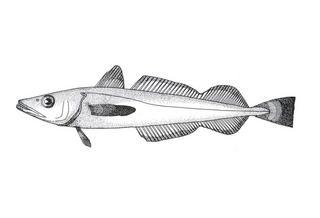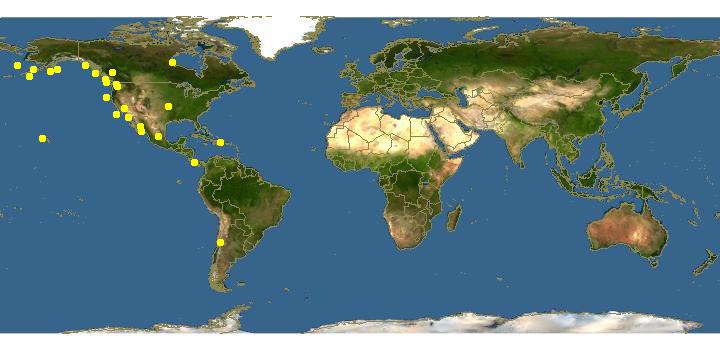
www.fao.org Copyright Michel Lamboeuf · 0
Merluccius productus |

Click on map for details about points.
|
| Links |
We parsed the following live from the Web into this page. Such content is managed by its original site and not cached on Discover Life. Please send feedback and corrections directly to the source. See original regarding copyrights and terms of use.
- FishBase
|
|
español |
|
|
Overview |
Main identification features
- head less than 29 percent sl
- 2nd dorsal fin 39-44
- gill rakers 18-23
Elongate, compressed, tapering to a narrow tail base; head large (27-28.5% of standard length) and flattened, with a V shape crest on top; large eyes and mouth, lower jaw slightly projecting; jaw teeth long, strong and pointed; 18-23 relatively long rakers on first gill arch; fins without spines; 2 separate dorsal fins, the 1st shorter and higher, the 2nd with a long base (39-44) and partly divided by a notch; well developed, nonfilamentous pelvic fins, situated before the pectorals; tail fin short, slightly forked; scales small, 125-144 on the lateral line.
Color: Silvery above, whitish below.
Size: 91cm.
Habitat: pelagic.
Depth: 12-1400 m.
Oregon to and throughout the Gulf of California.
Attributes
Abundance: Common.
Cites: Not listed.
Climate Zone: North Temperate (Californian Province &/or Northern Gulf of California); Northern Subtropical (Cortez Province + Sinaloan Gap).
Depth Range Max: 1400 m.
Depth Range Min: 12 m.
Diet: bony fishes; Pelagic crustacea.
Eastern Pacific Range: Northern limit=58; Southern limit=23; Western limit=-139; Eastern limit=-107; Latitudinal range=35; Longitudinal range=32.
Egg Type: Pelagic; Pelagic larva.
Feeding Group: Carnivore.
FishBase Habitat: Bathypelagic.
Global Endemism: East Pacific endemic; TEP non-endemic; All species.
Habitat: Water column.
Inshore Offshore: Inshore; Offshore; In & Offshore.
IUCN Red List: Not evaluated / Listed.
Length Max: 91 cm.
Regional Endemism: Continent only; Continent; Temperate Eastern Pacific, primarily; California province, primarily; Tropical Eastern Pacific (TEP) non-endemic; All species.
Residency: Resident.
Salinity: Marine; Marine Only.
Water Column Position: Near Surface; Mid Water; Near Bottom; Water column only;
|
|
|
Names | |
|
|
|
Links to other sites | |
|
|
|
References |
- Ayres, W. O., 1855., Description of new species of Californian fishes. A number of short notices read before the Society at several meetings in 1855., Proceedings of the California Academy of Sciences (Series 1), 1:23-77.
- Eschmeyer , W. N. , Herald , E. S. and Hamman, H., 1983., A field guide to Pacific coast fishes of North America from the Gulf of Alaska to Baja California. Peterson Field Guide Ser. 28., Houghton Mifflin:336pp.
- Findley, L.T., Hendrickx, M.E., Brusca, R.C., van der Heiden, A.M., Hastings, P.A., Torre, J., 2003., Diversidad de la Macrofauna Marina del Golfo de California, Mexico., CD-ROM versión 1.0. Projecto de la Macrofauna del Golfo . Derechos reservados de los autores y Conservación Internacional.
- Galván-Magaña, F., Gutiérrez-Sánchez, F., Abitia-Cárdenas, L.A., Rodríguez-Romero, J., 2000., The distribution and affinities of the shore fishes of the Baja California Sur lagoons. In Aquatic Ecosystems of Mexico: Status and Scope. Eds. M. Manuwar, S.G. Lawrence, I.F. Manuwar & D.F. Malley. Ecovision World Monograph Series., Backhuys Publishers:383-398.
- Love, M.S., Mecklenburg, C.W., Mecklenburg, T.A., Thorsteinson, L.K., 2005., es of the West Coast and Alaska: a checklist of North Pacific and Artic Ocena species from Baja California to the Alaska-Yukon border., U.S. Department of the Interior, U.S. Geological Survey, Biological Resources Division, 288pp.
- Musick, J.A., Harbin, M.M., Berkeley, S.A., Burgess, G.H. Eklund, A.M., Findley, L., Gilmore, R.G., Golden, J.T., Ha, D.S., Huntsman, G.R., McGovern, J.C., Parker, S.J., Poss, S.G., Sala, E., & Schmidt, T.W., Sedberry, G.R., Weeks, H., Wright, S.G., 2000., Marine, estuarine, and diadromous fish stocks at risk of extinction in North America (exclusive of Pacific salmonids)., Fisheries, 25:6-30.
- Van der Heiden , A. M. and Findley, L. T., 1988., Lista de los peces marinos del sur de Sinaloa, México., Anales del Centro de Ciencias del Mar y Limnologia de la Universidad Autonoma Nacional de Mexico, 15:209-224.
|
|
|
Acknowledgements | |
I thank Ashley MacDonald and John Pickering, University of Georgia, for technical support in building this page.
|
|
| Supported by | |
|
Following modified from FishBase
|
Top | See original
http://www.fishbase.org/Summary/speciesSummary.php?genusname=Merluccius&speciesname=productus ---> http://192.134.151.83/Summary/speciesSummary.php?genusname=Merluccius&speciesname=productus
http://192.134.151.83/Summary/speciesSummary.php?genusname=Merluccius&speciesname=productus ---> https://fishbase.mnhn.fr/Summary/speciesSummary.php?genusname=Merluccius&speciesname=productus
https://fishbase.mnhn.fr/Summary/speciesSummary.php?genusname=Merluccius&speciesname=productus ---> https://fishbase.mnhn.fr/summary/Merluccius-productus.html
Merluccius productus, North Pacific hake : fisheries

You can
sponsor
this page
Common name (e.g. trout)
Genus + Species (e.g. Gadus morhua)
-

-
About this page
-
Languages
-
User feedbacks
-
Citation
-
Uploads
-
Related species
-


 North Pacific hake
Add your observation in
Fish Watcher
Upload your
photos
and
videos
North Pacific hake
Add your observation in
Fish Watcher
Upload your
photos
and
videos
Pictures
|
Google image
 Merluccius productus
Merluccius productus
Picture by
Archipelago Marine Research Ltd.
Teleostei (teleosts) >
Gadiformes
(Cods) >
Merlucciidae
(Merluccid hakes)
Etymology:
Merluccius:
Latin, mar, maris = the sea + Latin, lucius = pike (Ref.
45335
)
.
More on author:
Ayres
.
Environment: milieu / climate zone / depth range / distribution range
Ecology
Marine; brackish; pelagic-neritic; depth range 0 - 1000 m (Ref.
9316
), usually ? - 229 m (Ref.
2850
). Temperate; 51°N - 15°N, 130°W - 77°W (Ref.
58452
)
Eastern Pacific: northern Vancouver Island, Canada to northern part of the Gulf of California. A record from the Gulf of Alaska is doubtful.
Length at first maturity / Size / Weight / Age
Maturity: L
m
37.0
, range 34 - 40 cm
Max length : 83.0 cm TL male/unsexed; (Ref.
127973
); 105.0 cm TL (female); common length : 60.0 cm TL male/unsexed; (Ref.
1371
); max. published weight: 4.2 kg (Ref.
127973
); max. published weight: 4.2 kg; max. reported age: 16 years (Ref.
56527
)
Dorsal
spines
(total): 1;
Dorsal
soft rays
(total): 48-56;
Anal
spines
: 0;
Anal
soft rays
: 40 - 43. Head rather short. Pectoral fin tips usually reaching to or beyond the origin of anal fin. Caudal fin always concave. Color silvery on back grading to whitish ventrally.
Inhabit oceanic and coastal areas, but mainly on the continental shelf (Ref.
1371
). Although often classified as demersal, the distribution and behavior suggest a largely pelagic existence (Ref.
1371
). Adults live in large schools in waters overlying the continental shelf and slope except during the spawning season when they are found several hundred miles seaward (Ref.
1371
). A nocturnal feeder (Ref.
6885
) that feed on a variety of fishes and invertebrates (Ref.
1371
). Important prey for sea lions and small cetaceans (Ref.
2850
); also prey of dogfish (Ref.
11384
).
Cohen, D.M., T. Inada, T. Iwamoto and N. Scialabba
, 1990. FAO species catalogue. Vol. 10. Gadiform fishes of the world (Order Gadiformes). An annotated and illustrated catalogue of cods, hakes, grenadiers and other gadiform fishes known to date. FAO Fish. Synop. 125(10). Rome: FAO. 442 p. (Ref.
1371
)
IUCN Red List Status (Ref.
130435
)
Least Concern (LC)
; Date assessed:
01 May 2008
CITES
Not Evaluated
Not Evaluated
Threat to humans
Harmless
Human uses
Fisheries: highly commercial
FAO - Fisheries:
landings
,
species profile
; Publication:
search
|
FishSource
|
Sea Around Us
More information
Countries
FAO areas
Ecosystems
Occurrences
Introductions
Stocks
Ecology
Diet
Food items
Food consumption
Ration
Common names
Synonyms
Metabolism
Predators
Ecotoxicology
Reproduction
Maturity
Spawning
Spawning aggregation
Fecundity
Eggs
Egg development
Age/Size
Growth
Length-weight
Length-length
Length-frequencies
Morphometrics
Morphology
Larvae
Larval dynamics
Recruitment
Abundance
BRUVS
References
Aquaculture
Aquaculture profile
Strains
Genetics
Electrophoreses
Heritability
Diseases
Processing
Nutrients
Mass conversion
Collaborators
Pictures
Stamps, Coins Misc.
Sounds
Ciguatera
Speed
Swim. type
Gill area
Otoliths
Brains
Vision
Tools
E-book
|
Field guide
|
Identification keys
|
Length-frequency wizard
|
Life-history tool
|
Point map
|
Classification Tree
|
Catch-MSY
|
Special reports
Check for Aquarium maintenance
|
Check for Species Fact Sheets
|
Check for Aquaculture Fact Sheets
Download XML
Summary page
|
Point data
|
Common names
|
Photos
Internet sources
AFORO (otoliths)
|
Aquatic Commons
|
BHL
|
Cloffa
|
BOLDSystems
|
Websites from users
|
Check FishWatcher
|
CISTI
|
Catalog of Fishes
:
genus
,
species
|
DiscoverLife
|
ECOTOX
| FAO - Fisheries:
landings
,
species profile
; Publication:
search
|
Faunafri
| Fishipedia |
Fishtrace
| GenBank:
genome
,
nucleotide
|
GloBI
|
Google Books
|
Google Scholar
|
Google
|
IGFA World Record
|
MitoFish
|
OceanAdapt
|
Otolith Atlas of Taiwan Fishes
|
PubMed
| Reef Life Survey | Socotra Atlas |
Tree of Life
| Wikipedia:
Go
,
Search
| World Records Freshwater Fishing |
Zoological Record
Estimates based on models
Preferred temperature (Ref.
123201
): 7 - 12.6, mean 8.6 °C (based on 23 cells).
Phylogenetic diversity index (Ref.
82804
): PD
50
= 0.5000 [Uniqueness, from 0.5 = low to 2.0 = high].
Bayesian length-weight: a=0.00457 (0.00381 - 0.00548), b=3.10 (3.05 - 3.15), in cm total length, based on LWR estimates for this species (Ref.
93245
).
Trophic level (Ref.
69278
): 4.4 ±0.0 se; based on diet studies.
Resilience (Ref.
120179
): Medium, minimum population doubling time 1.4 - 4.4 years (tmax=17; tm=4; also Musick et al. 2000 (Ref.
36717
)).
Prior r = 0.49, 95% CL = 0.33 - 0.74, Based on 3 stock assessments.
Fishing Vulnerability (Ref.
59153
): Moderate vulnerability (43 of 100).
Climate Vulnerability (Ref.
125649
): Moderate to high vulnerability (53 of 100).
Price category (Ref.
80766
):
Low
.
Nutrients (Ref.
124155
): Calcium = 10.2 [5.9, 23.4] mg/100g; Iron = 0.258 [0.108, 0.535] mg/100g; Protein = 18.1 [17.0, 19.4] %; Omega3 = 0.307 [0.183, 0.505] g/100g; Selenium = 21.6 [9.0, 51.7] μg/100g; VitaminA = 17.2 [5.7, 53.3] μg/100g; Zinc = 0.357 [0.261, 0.491] mg/100g (wet weight); based on
nutrient studies.
Back to Search
Random Species
Back to Top
Accessed through:
Not available
FishBase mirror site :
localhost
Page last modified by :
mrius-barile
- 20 July 2016
Fatal error
: Uncaught ArgumentCountError: Too few arguments to function checkEcotox(), 1 passed in /var/www/html/summary/speciessummary.php on line 2304 and exactly 3 expected in /var/www/html/includes/speciessummary.lib.php:2579 Stack trace: #0 /var/www/html/summary/speciessummary.php(2304): checkEcotox() #1 {main} thrown in
/var/www/html/includes/speciessummary.lib.php
on line
2579
|
Updated: 2024-05-23 06:27:51 gmt
|